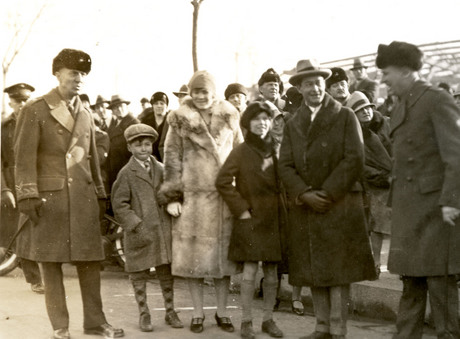(This is our seventh post about the films of diplomat John Van Antwerp MacMurray. See the first post for more background.)

MacMurray and his wife and two oldest children at a military review in January 1928 in Tientsin. Left General Smedley Butler (John Van Antwerp MacMurray Papers, Box 145)
On August 8, 1926, during a family vacation in Chefoo (the summer headquarters of the US Asiatic Fleet), MacMurray wrote his mother that her grandson had problems staying loyal to the Marines in Peking. After doing battle practice on a four-inch gun destroyer he had told his father: “I find that the sailors are as playful as the Marines.” As members of a diplomat’s family, MacMurray’s children were well acquainted with the US Marines and Navy in China. The films featured here capture naval ships in Chefoo harbor and Marines parading at the Peking Legation, as well as military airplanes, artillery, and tanks during reviews on Marine bases in Hsin Ho and Tientsin. The films include shots of the highly decorated “Fighting Quaker” General Smedley D. Butler, commander of the Marine Expeditionary Force between 1927 and 1929.
This film was shot in Chefoo (Yantai) and Penglai, where the MacMurray family spent summer vacation in 1926. It opens with elaborate views of ships at Chefoo harbor, which is followed by target practice on the USS Pruitt, from which the previous footage was probably shot (2:00). After images of a car being transferred across the water, the film continues with footage of Penglai, a small medieval town with an inner harbor and a temple on top of a rock (3:47). The rare footage of airplanes that follows (3:59) was shot at Camp MacMurray, the first US Marine airbase in China, which was established by Butler at Hsin Ho and named after MacMurray. It is not clear when MacMurray, who appears to have been taken on a flying tour, visited the base. The last part of the film captures artillery and tanks of the 10th Marine regiment in Tientsin on an unknown occasion (6:57), ending with marching British troops at Tientsin.
This film opens with a parade of the Legation Guard (abbreviated by MacMurray as “Lagu” Guard), followed by some brief footage of General Smedley Butler (0:19). (For more information and extensive footage of the Legation Guard see our previous post.) The footage that follows (1:19) captures the building of the Sino-American highway from Tientsin to Peking, a project that took place under Butler’s supervision in the fall of 1928, when the Third Brigade of the US Marines in Tientsin cooperated with Nationalist troops. A commemorative photo album of the project can be found in MacMurray’s Papers (box 147). The films ends with shots of marching Scottish soldiers at the Peking legation and more footage of General Butler (1:42).
After some village and nature scenes in the Western Hills, the fragments on this film include some more footage of the Legation Guard parading in the Peking compound (0:47). This is followed by what may be a Chinese burial procession of someone of importance, showing grieving people carrying banners and puppets of people and animals (1:33).
Our thanks to Dirk Haig for his assistance with identifying military images and to Shuwen Cao for her help with the local scenes.
Previous posts about the films of John Van Antwerp MacMurray:
